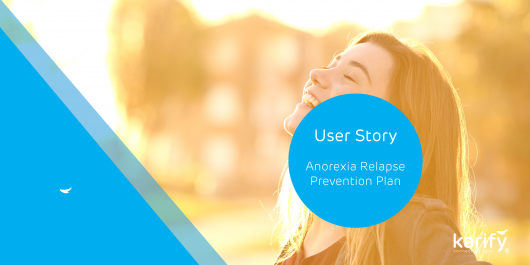Successfully integrated Anorexia Relapse Prevention [Part 2]

30 to 50 percent of people being treated for Anorexia Nervosa fall back after going through a successful treatment. A very high percentage that has to be reduced, according to the therapists at Altrecht Eating Disorders Rintveld. That is why they developed a Guideline Relapse Prevention, which was later integrated with an e-digital health treatment in Karify.
The treatment consists of making a personal relapse prevention plan and a follow-up care program that consists of a limited number of contact moments with the therapist. The results are promising: the relapse rates at Altrecht Eating Disorders Rintveld have been reduced to 11 percent!
We talked about the new approach with Tamara Berends, a nursing Specialist at Altrecht Eating Disorders Rintveld. Last week, we published part 1. This blog post features part 2 of the interview.
How do clients react to the new way of working?
“A qualitative survey among dozens of clients and parents shows what makes the relapse prevention so successful: clients and family members see it as a safety line that gives them a more secure feeling so that they are not afraid to take steps forward.”
Is this guideline also being applied externally?
“One of the reasons that we based the Guideline Relapse Prevention for Anorexia Nervosa (AN) on other problem areas is because the relapse process is similar to many diseases. The method as described in the relapse prevention AN directive is therefore widely applicable, but the power is in the details. It is important that clients are well informed about their specific disorder, what the risk of relapse is and in which period the risk is greatest.
For example, the Relapse Prevention Guideline AN is aimed at 1.5 years of low frequent contact, because in that period the risk of relapse is greatest for this target group. However, if you look at another eating disorder, for example, bulimia nervosa, you should act differently because the risk of relapse is greatest during the first 4 months after completing the treatment. Intensive guidance to prevent relapse should, therefore, take place during that specific period.
The relapse prevention method for bulimia nervosa, therefore, has a slightly different approach, but the integrated version in which a personal relapse prevention plan is drawn up is also extremely suitable here.
Integrated relapse prevention is already being used by other departments that work with patients with anorexia nervosa. I expect the guideline to be used more often as research shows positive effects.
This aftercare process ensures that practitioners and clients dare to close the treatment earlier. This possible shortening of treatment makes it is also interesting from a insurers perspective. ”
Would you like to know more about our research department: read more

